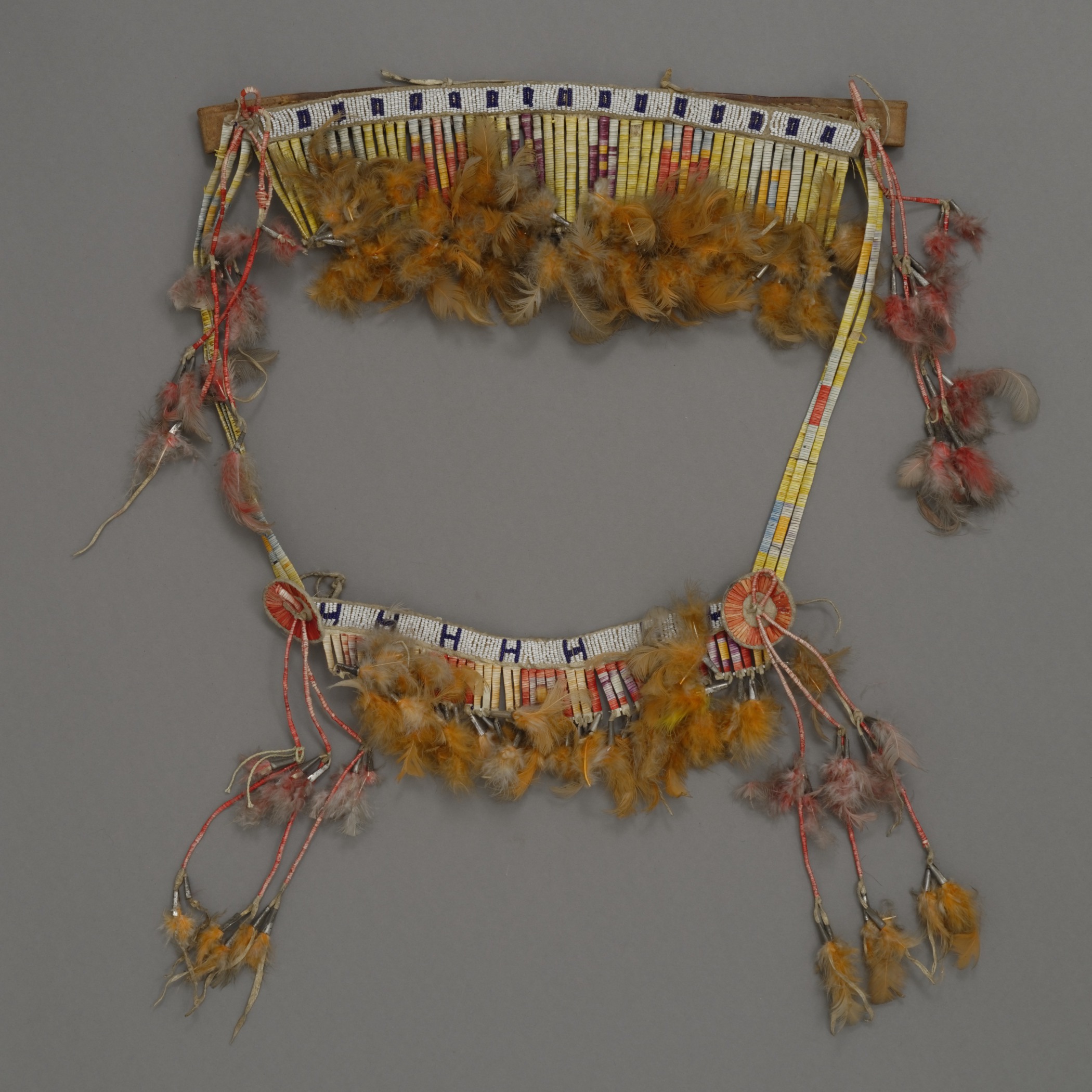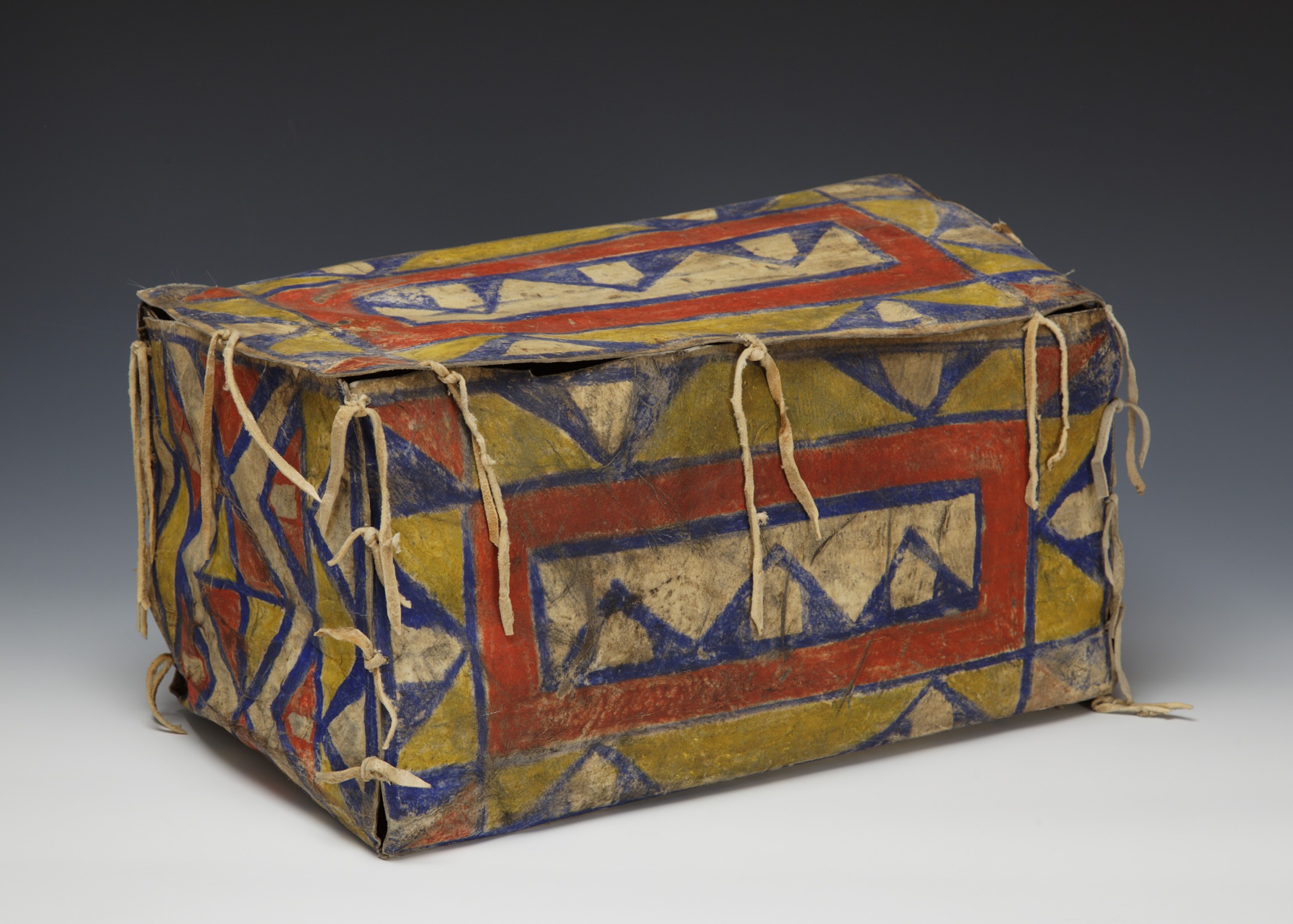Lakota (Teton Sioux)
Bridle decoration
- Late 19th century
- Leather, porcupine quills, glass beads, tin, feathers, and dye
- 6 3/16 × 6 5/16 in.
Hood Museum of Art, Dartmouth College: Bequest of Frank C. and Clara G. Churchill; 46.17.9837
visibilityLook & DiscussPlains warriors made their own saddles, bridles, cinches, whips, and ropes. Historically, they made simple bridles using twisted or woven horsehair or buffalo hair, rawhide, and tanned leather. They guided their mounts with a thin rawhide thong or rope of braided buffalo hair looped over the lower jaw.
Later, bridles became more elaborate and incorporated many influences, including Spanish saddles, Native American beadwork, and traditions of family and tribal identity. In the equipment created to dress and guide horses, Native American artists created a rich new visual art form.
explore the object
This bridle combines extraordinary quillwork with feather and beads. To make the straps, the artisan wrapped dyed, flattened porcupine quills around a strip of rawhide and stitched them in place. Straps of white and blue beads extended across the forehead and muzzle of the horse. The feathers that hang from the straps would have danced with the movements of the horse.
Related Objects
Sioux, beaded leather bridle, collected about 1908. Iron, leather, beads, tin, and feathers. Hood Museum of Art, Dartmouth College: Bequest of Frank C. and Clara G. Churchill; 46.17.9836.
Sioux, quirt, late 19th century. Leather and horse hair, 16 15/16 × 9/16 in. Hood Museum of Art, Dartmouth College: Gift of Glover Street Hastings III; 181.2.26045.
This bridle has an iron bit, leather cheek straps, a brow band, and reins. The soft leather of the cheek straps and brow band is covered with beadwork in a diagonal design of blue, red, and green beads on a white background, and trimmed with tin-wrapped red feathers. Additional beaded straps create an upside down Y that would have extended over the horse’s face and separated just above the animal’s muzzle.
A quirt, or short riding whip, was used to urge a horse to greater speed. Plains warriors also used them to “count coup.” A warrior would gallop up to an enemy in battle and, instead of killing him, would touch him with his quirt or with a special coup (koo) stick. Counting coup was a highly honored form of bravery.
Short Bull (Tatanka Ptecela), American (Lakota), about 1845–1915, Untitled (Short Bull Raiding Five Horses), page 32 from a Short Bull notebook, about 1885–90. Ink, watercolor, and graphite on wove blue-lined notebook paper, 7 5/8 × 10 in. Hood Museum of Art, Dartmouth College: Mark Lansburgh Ledger Drawing Collection; Partial gift of Mark Lansburgh, Class of 1949; and partial purchase through the Mrs. Harvey P. Hood W’18 Fund, and the Offices of the President and Provost of Dartmouth College; 2007.65.61.
Plains warriors often painted their horses in preparation for battle. A warrior would apply his personal honors to his war horse. Specific symbols indicated previous victories in battle or horses acquired. Other symbols provided protection for the warrior.
American (Southern Inunaina and/or Southern Tsistsistas), active late 19th century, Untitled (A Crazy Dog Society Warrior), page 172 from the Frank Henderson Ledger, about 1882. Graphite and colored pencil on laid ledger paper, 5 5/16 × 11 7/8 in. Hood Museum of Art, Dartmouth College: Mark Lansburgh Ledger Drawing Collection; Partial gift of Mark Lansburgh, Class of 1949; and partial purchase through the Mrs. Harvey P. Hood W’18 Fund, and the Offices of the President and Provost of Dartmouth College; 2007.65.51.
This finely drawn portrait of a warrior provides a great deal of information about the ways in which warriors and their horses were dressed for battle. This warrior has come to be known as “Horseback” based on the pictograph, or “glyph,” the artist drew to identify him (top left). Horseback’s clothing and the objects he holds identify him as an accomplished warrior with high standing in his community. He wears beaded leggings, a breechcloth of trade wool, an American military jacket, a long hair drop of German silver discs, and striped face paint. His magnificent lance has many eagle feathers, each one earned for an act of bravery. He also carries a painted shield with eagle feathers and a “donut” rattle. Warriors groomed their own horses for battle. Horseback has knotted up his horse’s tail to prevent the enemy from taking hold of it. He has also gathered its mane to prevent entanglement with a bow and arrow or gun during combat.






